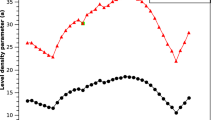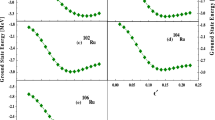Abstract
The structure properties of nuclei that reside significantly away from the line of \(\beta\)-stability are currently the focus of both theoretical and experimental studies. Various theoretical methodologies are being employed to explore these nuclear structure properties. In our research, we have calculated several structure properties, including binding energy, charge radii, root mean square (rms) radii and their isotopic variations, two-neutron separation energy, shell gap, chemical potential, quadrupole deformation, density distribution, and single-particle energy for thorium nuclei, which are found both on and off the line of \(\beta\)-stability. Thorium nuclei are particularly intriguing due to their diverse practical applications, including their role in thorium-based nuclear reactors and their involvement at various stages of nucleosynthesis. This study helps us gain insight into how nuclear properties change with the number of neutrons and enables us to predict shell closures and nuclear stability. The estimated values were compared with available experimental and theoretical data and are found to be in good agreement. The departure from a linear trend observed around specific neutron numbers, specifically N = 126, 138, and 184, in graphs depicting various properties against neutron number and single-particle energy gap, can be attributed to the concept of neutron magic numbers. Among these, N = 126 and N = 184 are considered neutron magic numbers, while N = 138 is regarded as a semi-magic number.











Similar content being viewed by others
Data Availability Statement
This manuscript has associated data in a data repository. [Authors’ comment: The data supporting the findings of this study are presented in figures].
References
B. Pfeiffer, K.-L. Kratz, F.-K. Thielemann, W. Walters, Nuclear structure studies for the astrophysical r-process. Nucl. Phys. A 693(1–2), 282–324 (2001)
R.K. Gupta, M. Balasubramaniam, S. Kumar, S. Patra, G. Munzenberg, W. Greiner, Magic numbers in exotic light nuclei near drip lines. J. Phys. G Nucl. Particle Phys. 32(4), 565 (2006)
D. Vretenar, Nuclear structure far from stability. Nucl. Phys. A 751, 264–281 (2005)
C. He, J.-Y. Guo, Structure and \(\alpha\) decay for the neutron-deficient nuclei with 89\(\le\) z\(\le\) 94 in the density-dependent cluster model combined with a relativistic mean-field approach. Phys. Rev. C 106(6), 064310 (2022)
B.A. Marsh, T. Day Goodacre, S. Sels, Y. Tsunoda, B. Andel, A.N. Andreyev, N. Althubiti, D. Atanasov, A. Barzakh, J. Billowes et al., Characterization of the shape-staggering effect in mercury nuclei. Nat. Phys. 14(12), 1163–1167 (2018)
X. Yang, C. Wraith, L. Xie, C. Babcock, J. Billowes, M. Bissell, K. Blaum, B. Cheal, K. Flanagan, R.G. Ruiz et al., Isomer shift and magnetic moment of the long-lived 1/2+ isomer in zn 49 30 79: Signature of shape coexistence near ni 78. Phys. Rev. Lett. 116(18), 182502 (2016)
A. Krasznahorkay, H. Akimune, A. Van Den Berg, N. Blasi, S. Brandenburg, M. Csatlo, M. Fujiwara, J. Gulya, M. Harakeh, M. Hunyadi et al., Neutron-skin thickness in neutron-rich isotopes. Nucl. Phys. A 731, 224–234 (2004)
W. Nortershauser, D. Tiedemann, M. Zakova, Z. Andjelkovic, K. Blaum, M.L. Bissell, R. Cazan, G. Drake, C. Geppert, M. Kowalska et al., Nuclear charge radii of be 7, 9, 10 and the one-neutron halo nucleus be 11. Physical review letters 102(6), 062503 (2009)
C. Gorges, L. Rodriguez, D. Balabanski, M. Bissell, K. Blaum, B. Cheal, R.G. Ruiz, G. Georgiev, W. Gins, H. Heylen et al., Laser spectroscopy of neutron-rich tin isotopes: a discontinuity in charge radii across the n= 82 shell closure. Phys. Rev. Lett. 122(19), 192502 (2019)
B. Bastin, S. Grevy, D. Sohler, O. Sorlin, Z. Dombradi, N. Achouri, J. Angelique, F. Azaiez, D. Baiborodin, R. Borcea, et al.: Collapse of the n= 28 shell closure in si-42. Phys. Rev. Lett. 99(2) (2007)
F. Sarazin, H. Savajols, W. Mittig, F. Nowacki, N. Orr, Z. Ren, P. Roussel-Chomaz, G. Auger, D. Baiborodin, A. Belozyorov et al., Shape coexistence and the n= 28 shell closure far from stability. Phys. Rev. Lett. 84(22), 5062 (2000)
M. Bender, P.-H. Heenen, P.-G. Reinhard, Self-consistent mean-field models for nuclear structure. Rev. Mod. Phys. 75(1), 121 (2003)
T. Niks̆ić, D. Vretenar, P. Ring, Progress in Particle and Nuclear Physics 66(3), 519–548 (2011) 10.1016/j.ppnp.2011.01.055
D. Vretenar, A.V. Afanasjev, G.A. Lalazissis, P. Ring, Physics Reports 409(3), 101–259 (2005). https://doi.org/10.1016/j.physrep.2004.10.001
T. Nikšić, D. Vretenar, P. Ring, Relativistic nuclear energy density functionals: adjusting parameters to binding energies. Phys. Rev. C 78(3), 034318 (2008)
Y. Tian, Z.Y. Ma, P. Ring, A finite range pairing force for density functional theory in superfluid nuclei. Phys. Lett. B 676(1), 44–50 (2009). https://doi.org/10.1016/j.physletb.2009.04.067
K. Pomorski, P. Ring, G. Lalazissis, A. Baran, Z. Lojewski, B. Nerlo-Pomorska, M. Warda, Ground state properties of the \(\beta\) stable nuclei in various mean field theories. Nucl. Phys. A 624(3), 349–369 (1997)
A. Ozawa, T. Suzuki, I. Tanihata, Nuclear size and related topics. Nucl. Phys. A 693(1–2), 32–62 (2001)
B. Cheal, K. Flanagan, Progress in laser spectroscopy at radioactive ion beam facilities. J. Phys. G Nucl. Part. Phys. 37(11), 113101 (2010)
K. Blaum, J. Dilling, W. Nortershauser, Precision atomic physics techniques for nuclear physics with radioactive beams. Phys. Scripta 2013(T152), 014017 (2013)
I.U. Roederer, K.-L. Kratz, A. Frebel, N. Christlieb, B. Pfeiffer, J.J. Cowan, C. Sneden, The end of nucleosynthesis: production of lead and thorium in the early galaxy. Astrophys. J. 698(2), 1963 (2009)
A. Choplin, S. Goriely, L. Siess, Synthesis of thorium and uranium in asymptotic giant branch stars. Astron. Astrophys. 667, 13 (2022)
Niks̆ić, T., Paar, N., Vretenar, D., Ring, P., DIRHB A relativistic self-consistent mean-field framework for atomic nuclei. Comput. Phys. Commun. 185(6), 1808–1821 (2014). https://doi.org/10.1016/.cpc.2014.02.027
J. Boguta, A. Bodmer, Relativistic calculation of nuclear matter and the nuclear surface. Nucl. Phys. A 292(3), 413–428 (1977)
W. Pannert, P. Ring, J. Boguta, Relativistic mean-field theory and nuclear deformation. Phys. Rev. Lett. 59(21), 2420 (1987)
R. Brockmann, H. Toki, Relativistic density-dependent hartree approach for finite nuclei. Phys. Rev. Lett. 68(23), 3408 (1992)
F. Hofmann, C. Keil, H. Lenske, Density dependent hadron field theory for asymmetric nuclear matter and exotic nuclei. Phys. Rev. C 64(3), 034314 (2001)
S. Typel, H.H. Wolter, Nucl. Phys. A 656(3), 331–364 (1999). https://doi.org/10.1016/S0375-9474(99)00310-3
T. Niksic, D. Vretenar, P. Finelli, P. Ring, Relativistic hartree-bogoliubov model with density-dependent meson-nucleon couplings. Phys. Rev. C 66(2), 024306 (2002)
F. Jong, H. Lenske, Asymmetric nuclear matter in the relativistic Brueckner-Hartree-Fock approach. Phys. Rev. C 57, 3099–3107 (1998) 10.1103/PhysRevC.57.3099
P. Manakos, T. Mannel, Renormalized relativistic hartree fock models with skyrme type interactions. Zeitschrift für Physik A Atomic Nuclei 334, 481–489 (1989)
J.J. Rusnak, R.J. Furnstahl, Nucl. Phys. A 627(3), 495 (1997). https://doi.org/10.1016/S0375-9474(97)00598-8
T. Bürvenich, D.G. Madland, J.A. Maruhn, P.-G. Reinhard, Nuclear ground state observables and QCD scaling in a refined relativistic point coupling model. Phys. Rev. C 65: 044308 (2002) 10.1103/PhysRevC.65.044308
P.W. Zhao, Z.P. Li, J.M. Yao, Meng, J. Phys. Rev. C 82, 054319 (2010) 10.1103/PhysRevC.82.054319
R. Machleidt, The meson theory of nuclear forces and nuclear structure. Springer, 189–376 (1989)
P. Ring, P. Schuck, The nuclear many-body problem. Springer Science & Business Media (2004)
G.A. Lalazissis, T. Niksic, D. Vretenar, P. Ring, Phys. Rev. C 71, 024312 (2005). https://doi.org/10.1103/PhysRevC.71.024312
B. Kumar, S.K. Biswal, S.K. Singh, S.K. Patra, Phys. Rev. C 92, 054314 (2015). https://doi.org/10.1103/PhysRevC.92.054314
P. Möller, A.J. Sierk, T. Ichikawa, H. Sagawa, Atomic Data and Nuclear Data Tables 109–110, 1–204 (2016). https://doi.org/10.1016/j.adt.2015.10.002
https://www.nndc.bnl.gov/nudat3/
G. Alkhazov, S. Belostotsky, O. Domchenkov, Y.V. Dotsenko, N. Kuropatkin, M. Schuvaev, A. Vorobyov, Nuclear sizes of 40, 48ca and 32, 34s isotopes determined from 1 gev proton elastic scattering. Phys. Lett. B 57(1), 47–50 (1975)
I. Angeli, K.P. Marinova, Atomic Data and Nuclear Data Tables 99(1), 69 (2013). https://doi.org/10.1016/j.adt.2011.12.006
W. Seif, H. Mansour, Systematics of nucleon density distributions and neutron skin of nuclei. Int. J. Modern Phys. E 24(11), 1550083 (2015)
Chishti, M.M.R., O Donnell, D., Battaglia, G., Bowry, M., Jaroszynski, D.A., Singh, B.S.N., Scheck, M., Spagnoletti, P., Smith, J.F. Nature Physics. 16, 1853 (2020) 10.1038/s41567-020-0899-4
S. Raman, C. Nestor Jr., P. Tikkanen, Transition probability from the ground to the first-excited 2+ state of even-even nuclides. Atomic Data and Nuclear Data Tables 78(1), 1–128 (2001)
G. Saxena, M. Kumawat, M. Kaushik, S.K. Jain, M. Aggarwal, Phys. Lett. B 788, 1–6 (2019). https://doi.org/10.1016/j.physletb.2018.08.076
Acknowledgements
Ummukulsu E. acknowledges with thanks the financial support from CSIR, Govt. of India, by way of the fellowship under the SRF scheme. The authors wish to thank the Department of Computer Science, University of Calicut, for providing with the necessary computing facilities to carry out this work.
Author information
Authors and Affiliations
Corresponding author
Rights and permissions
Springer Nature or its licensor (e.g. a society or other partner) holds exclusive rights to this article under a publishing agreement with the author(s) or other rightsholder(s); author self-archiving of the accepted manuscript version of this article is solely governed by the terms of such publishing agreement and applicable law.
About this article
Cite this article
Ummukulsu, E., Joseph, A. Investigation on the structure properties of thorium nuclei spanned between the drip-lines and the prediction of shell closure. Eur. Phys. J. Plus 138, 1077 (2023). https://doi.org/10.1140/epjp/s13360-023-04742-3
Received:
Accepted:
Published:
DOI: https://doi.org/10.1140/epjp/s13360-023-04742-3




